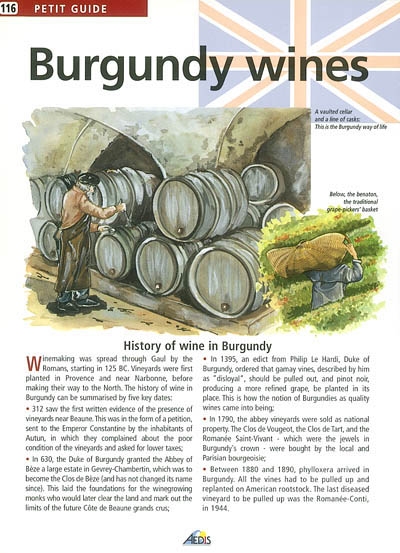en savoir plus

Permet à tous ses détenteurs d'obtenir 5% de réduction sur tous les livres lors du retrait en magasin (réduction non cumulable avec les réductions de type étudiant).
Offre également un certain nombre d'avantages auprès de nos partenaires.
Avec les favoris, retrouvez dans un espace les sélections effectuées au fur et à mesure de vos navigations dans le site.
Constituez pour votre usage personnel vos listes de livres en prévisions d'achats futurs et votre sélection d'articles, dossiers, événements, vidéos ou podcasts préférés ou à découvrir plus tard...
Il suffit simplement de cliquer sur "Ajout Favori" sur chaque page qui vous intéresse pour les retrouver ensuite dans votre espace personnel.
Requiert un compte Mollat
Requiert un compte Mollat
Burgundy wines
Auteur : Florence Kennel
en savoir plus
Résumé
Donne des informations historiques et géographiques sur la production et les cépages, un récapitulatif des principales AOC et des millésimes, des conseils pour lire une étiquette et pour servir le vin de Bourgogne. ©Electre 2025
Quatrième de couverture
Appellation Beaune contrôlée : you could equally see "appellation Beaune premier cru contrôlée" or "appellation contrôlée". One of the three wordings must appear on all bottles of Burgundy (where no vin de pays or table wine is produced).
Clos des Mouches : the name of the particular `climate'. Here we can only tell that it is a premier cru by guessing, as it is not compulsory to state this on the label. Note the difference in size between "Beaune" and "Clos des Mouches". This is because Clos is a well known climate.
Récolte du domaine (estate picked) : indicates that Joseph Drouhin is the owner of the Clos des Mouches and that he has not bought in grapes from other vine growers. The use of the word `domaine' (estate) (as in "mis en bouteille au domaine" -estate bottled) is exclusively reserved for vineyard owners.
Mis en bouteille par (bottled by) :
- «Joseph Drouhin» : indicates a wine trader or a vine grower. To find out whether the wine was bottled by one or the other, you must to look at the green cap : if "récoltant" is written on it, it means that the wine has been bottled by the vine grower. However, bear in mind that a number of caps are customised and no longer show this standard information.
- "Joseph Drouhin, propriétaire-récoltant" (owner/harvester) or "viticulteur" (grower) or "mis en bouteille au château" (château bottled) indicate that the bottler is the owner of the vineyards and that it is a private cellar.
- "Joseph Drouhin, négociant éleveur" : indicates a wine merchant.
- "Cave des Vignerons de Beaune" : indicates a cooperative.
How to serve Burgundy wine
ù Selecting the right glass :
- A rounded glass for reds, to hold in the particularly delicate aromas of pinot noir.
- A narrower glass for whites, to bring out the acidity.
ù Decanting : a word of caution
Pinot noir is a variety with a fragile colour and aromas : an old burgundy is more susceptible to oxidation than a bordeaux. If you decant it, you may end up with a reddish-brown, flat wine. However, oxygen may add life to vintages that age well and often have a closed nose : 1993, 1995 and 1996.
ù Choosing the right temperature.
- 14° to 16° for reds (no more, othenvise the alcohol will overpower the fruit).
- 12° for whites (no less or the aromas will be masked by the soft fullness).
Fiche Technique
Paru le : 10/09/2002
Thématique : Viticulture
Auteur(s) : Auteur : Florence Kennel
Éditeur(s) :
Aedis
Collection(s) : Petit guide
Contributeur(s) : Illustrateur : Carine Planchon - Illustrateur : Pierre Quentin
Série(s) : Non précisé.
ISBN : Non précisé.
EAN13 : 9782842591809
Pages : 8
Hauteur: 22.0 cm / Largeur 16.0 cm
Poids: 50 g

